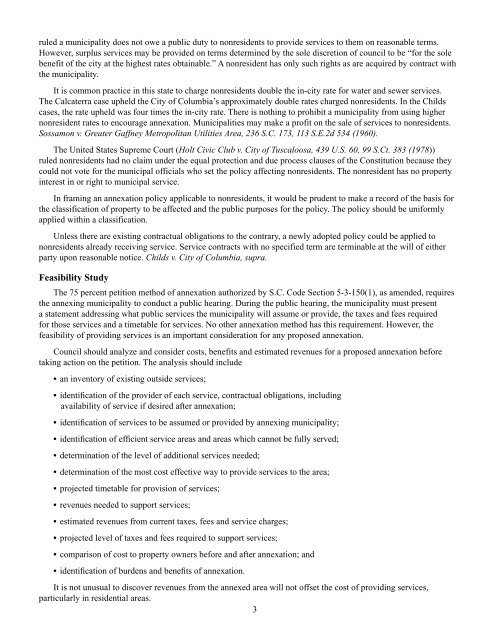Annexation Handbook - Municipal Association of South Carolina
Annexation Handbook - Municipal Association of South Carolina
Annexation Handbook - Municipal Association of South Carolina
You also want an ePaper? Increase the reach of your titles
YUMPU automatically turns print PDFs into web optimized ePapers that Google loves.
uled a municipality does not owe a public duty to nonresidents to provide services to them on reasonable terms.<br />
However, surplus services may be provided on terms determined by the sole discretion <strong>of</strong> council to be “for the sole<br />
benefit <strong>of</strong> the city at the highest rates obtainable.” A nonresident has only such rights as are acquired by contract with<br />
the municipality.<br />
It is common practice in this state to charge nonresidents double the in-city rate for water and sewer services.<br />
The Calcaterra case upheld the City <strong>of</strong> Columbia’s approximately double rates charged nonresidents. In the Childs<br />
cases, the rate upheld was four times the in-city rate. There is nothing to prohibit a municipality from using higher<br />
nonresident rates to encourage annexation. <strong>Municipal</strong>ities may make a pr<strong>of</strong>it on the sale <strong>of</strong> services to nonresidents.<br />
Sossamon v. Greater Gaffney Metropolitan Utilities Area, 236 S.C. 173, 113 S.E.2d 534 (1960).<br />
The United States Supreme Court (Holt Civic Club v. City <strong>of</strong> Tuscaloosa, 439 U.S. 60, 99 S.Ct. 383 (1978))<br />
ruled nonresidents had no claim under the equal protection and due process clauses <strong>of</strong> the Constitution because they<br />
could not vote for the municipal <strong>of</strong>ficials who set the policy affecting nonresidents. The nonresident has no property<br />
interest in or right to municipal service.<br />
In framing an annexation policy applicable to nonresidents, it would be prudent to make a record <strong>of</strong> the basis for<br />
the classification <strong>of</strong> property to be affected and the public purposes for the policy. The policy should be uniformly<br />
applied within a classification.<br />
Unless there are existing contractual obligations to the contrary, a newly adopted policy could be applied to<br />
nonresidents already receiving service. Service contracts with no specified term are terminable at the will <strong>of</strong> either<br />
party upon reasonable notice. Childs v. City <strong>of</strong> Columbia, supra.<br />
Feasibility Study<br />
The 75 percent petition method <strong>of</strong> annexation authorized by S.C. Code Section 5-3-150(1), as amended, requires<br />
the annexing municipality to conduct a public hearing. During the public hearing, the municipality must present<br />
a statement addressing what public services the municipality will assume or provide, the taxes and fees required<br />
for those services and a timetable for services. No other annexation method has this requirement. However, the<br />
feasibility <strong>of</strong> providing services is an important consideration for any proposed annexation.<br />
Council should analyze and consider costs, benefits and estimated revenues for a proposed annexation before<br />
taking action on the petition. The analysis should include<br />
• an inventory <strong>of</strong> existing outside services;<br />
• identification <strong>of</strong> the provider <strong>of</strong> each service, contractual obligations, including<br />
availability <strong>of</strong> service if desired after annexation;<br />
• identification <strong>of</strong> services to be assumed or provided by annexing municipality;<br />
• identification <strong>of</strong> efficient service areas and areas which cannot be fully served;<br />
• determination <strong>of</strong> the level <strong>of</strong> additional services needed;<br />
• determination <strong>of</strong> the most cost effective way to provide services to the area;<br />
• projected timetable for provision <strong>of</strong> services;<br />
• revenues needed to support services;<br />
• estimated revenues from current taxes, fees and service charges;<br />
• projected level <strong>of</strong> taxes and fees required to support services;<br />
• comparison <strong>of</strong> cost to property owners before and after annexation; and<br />
• identification <strong>of</strong> burdens and benefits <strong>of</strong> annexation.<br />
It is not unusual to discover revenues from the annexed area will not <strong>of</strong>fset the cost <strong>of</strong> providing services,<br />
particularly in residential areas.<br />
3
















